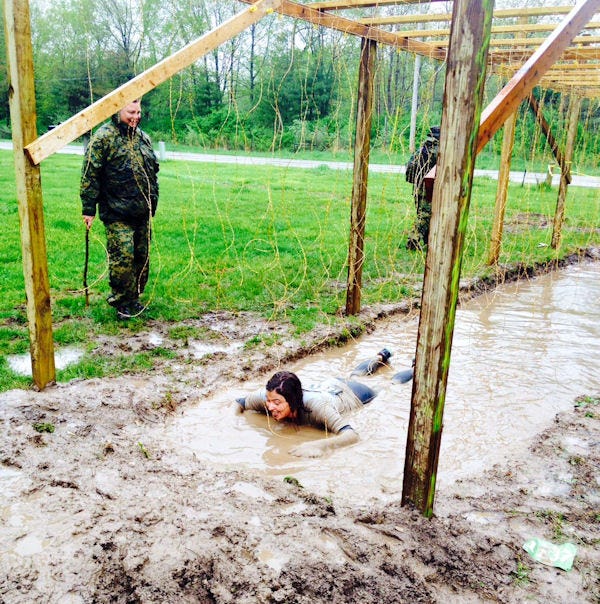
Have you ever been talked into something that you have no real, earthly reason for agreeing to? Like, say, trading in a perfectly good tractor? Or, in my case, agreeing to run 3.1 miles in the rain and mud that ends in a 40-foot polar plunge and electrical shock?
You know. Hypothetically speaking.
Except not hypothetical. Friends Allison, Cara and Colleen talked me into joining their team for the Fight to the Finish race this spring, near Peoria. The idea was a 5K race, through parts of Wildlife Prairie Park, encountering a variety of challenges along the way. I said, “Sure, let’s do it!” Then I studied the website. In retrospect, I should’ve switched the order of those two events.

DELIRIOUS: It was over and that's why we're smiling. Really. As for why two of us are clean and two are muddy? We were all washed clean in the 40-foot polar plunge drop, then two crawled through the electroshock mud challenge and two ran. #rawwomen
Sure enough, race day arrived. It was a rainy, 45-degree April morning. I have never been more sincere than when I told my husband, “All I want is to stay home and make pancakes.”
We arrived, with an 8:50 a.m. start time. It’s been awhile since I’ve dreaded the mechanics of something this much.
We started. We ran in the rain. We climbed over obstacles. We slipped along mud paths. We clawed our way up muddy embankments. We ran through woods and along lakes. We fell. We ran through mud pits while people threw dodge balls at us. That was weird. We crawled through mud-filled culverts. That was hard.
Jesus in a boat

WHAT IN THE WORLD: This is Colleen, trying to figure out why it was hurting. Note the military man laughing on the side.
Finally, the polar plunge. We sat atop a 40-foot slide and plunged into a lake, with a 50-yard swim to the dock on the far side. I am here to tell you, I have never been through a more physically shocking experience in my life. Underwater, kicking and trying to swim. Can’t breathe. Hyperventilating, I kicked with mud-laden tennis shoes and thought, “I have to be almost there.”
I looked to the dock. I hadn’t moved. The race people identified me as a struggler and a woman in a boat yelled, “Grab the pool noodle!”
I looked. That noodle was maybe 20 feet away and it might as well have been 20 miles. The woman and the boat were just as far in the opposite direction and I thought, “Well, this is it. This is where it’s all gonna end. Is that Jesus in that boat?”
But a larger part of me said I would not go down this way. I would not be pulled out in a boat. Not today, friends. I swam. I thought I was going to die but I just kept swimming.
I made it to the ladder, to the dock, up the bank. I couldn’t speak and I could barely walk.
Then the last challenge and the sign: “Electroshock Therapy.” Dangling electric fence wires, over a 30-foot-long mud pit.

ZAP: This is me, at about the point when I began to get shocked for all I was worth. Note the (real) insulators and (real) fence charger. And somehow this is legal. And I signed up for it.
Allison and I spent the last mile of the race talking about how this thing couldn’t possibly be as hot as an electric fence. You can’t stand in knee-deep mud and get shocked like that, right? You could die. We figured it had to be a light version. We were wrong. And this is apparently legal.
Therapy needed
Colleen headed in first. She was smiling and running and had her eyes on the finish line while yelling, “Let’s finish strong girls!” And somehow, she had absolutely no idea those wires were hot.
She got about halfway through it and she began to go down like she’d been shot multiple times in a war. She was laying there in the mud, trying to figure out why it kept hurting. She got a final zap and completely face-planted in the mud. She was forced to crawl forward and roll out the side.
We were stunned. We couldn’t believe what we just saw. Is she even ok? The military guys manning the station were yelling at us, “Don’t go in after her! It’ll be worse for both of you!”
We had no idea what to do next. Should we belly-crawl through the mud and stay under the wires? Or run through? Colleen was still on the ground. Other runners saw her go down and bypassed the whole thing. The military guys were yelling at us: “Make a command decision!”
Allison ran. She didn’t have her arms high enough and took one on the forehead. Cara crawled. She was like a crocodile: only the top of her head and her eyes above water. She didn’t get a single shock.
Perhaps because of my most recent underwater experience, I couldn’t bring myself to get down in the mud again. So I went against every grain of farm kid common sense that says AVOID ELECTRIC FENCE and decided to run. I ran through, arms up, full bore, taking maybe a dozen hits to my forearms.
But you guys, we did it. We crossed the finish line.
And I will tell you, the singular thought the crossed my mind throughout the race? Do hard things.
Just do them.
Do the things you think you can’t do.
Think you can't chair a committee? Do it. Think you can't add a business? Do it. Think you can't solve a problem? Dive in. Do it.
You might just surprise yourself. You might hyperventilate and almost die and be shocked silly. But you can do it.
About the Author(s)
You May Also Like






